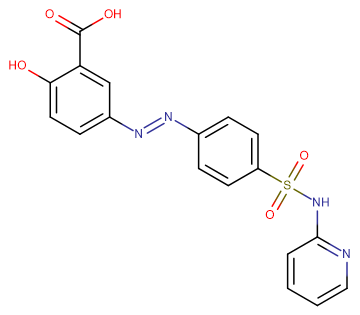
Sulfasalazine
CAS No. 599-79-1
Sulfasalazine( Azopyrin | NSC 203730 | NSC 667219 )
Catalog No. M15233 CAS No. 599-79-1
Sulfasalazine, a sulfa agent and a derivative of mesalazine, is used primarily as an anti-inflammatory agent.
Purity : >98% (HPLC)
 COA
COA
 Datasheet
Datasheet
 HNMR
HNMR
 HPLC
HPLC
 MSDS
MSDS
 Handing Instructions
Handing Instructions
| Size | Price / USD | Stock | Quantity |
| 500MG | 41 | In Stock |


|
| 1G | 48 | In Stock |


|
Biological Information
-
Product NameSulfasalazine
-
NoteResearch use only, not for human use.
-
Brief DescriptionSulfasalazine, a sulfa agent and a derivative of mesalazine, is used primarily as an anti-inflammatory agent.
-
DescriptionSulfasalazine, a sulfa agent and a derivative of mesalazine, is used primarily as an anti-inflammatory agent. Target: Others Sulfasalazine (Azulfidine), used to treat pain and swelling in arthritis, belongs to a class of drugs called sulfa drugs.(In Vitro):Treatment of SW620 colon cells with sulfasalazine inhibits TNFα-, LPS-, or phorbol ester-induced NFκB activation. NFκB-dependent transcription is inhibited by sulfasalazine at micro- to millimolar concentrations. TNFα-induced nuclear translocation of NFκB is prevented by sulfasalazine through inhibition of IκBα degradation. Pre-incubation with 5 mM of sulfasalazine alone significantly increases basal mRNA expression of all pro-inflammatory cytokines with levels of IL-6 mRNA increased by 80-fold compared with vehicle control. Once digested, sulfasalazine is cleaved into sulfapyridine and 5-aminosalicylic acid by colonic bacteria, and the latter, too, is reported to suppress NF-kappaB activity.(In Vivo):At low doses (0.25 mM), SAS is able to suppress glioma growth by over 60% compared to untreated controls.
-
In VitroTreatment of SW620 colon cells with sulfasalazine inhibits TNFα-, LPS-, or phorbol ester-induced NFκB activation. NFκB-dependent transcription is inhibited by sulfasalazine at micro- to millimolar concentrations. TNFα-induced nuclear translocation of NFκB is prevented by sulfasalazine through inhibition of IκBα degradation. Pre-incubation with 5 mM of sulfasalazine alone significantly increases basal mRNA expression of all pro-inflammatory cytokines with levels of IL-6 mRNA increased by 80-fold compared with vehicle control. Once digested, sulfasalazine is cleaved into sulfapyridine and 5-aminosalicylic acid by colonic bacteria, and the latter, too, is reported to suppress NF-kappaB activity.
-
In VivoAt low doses (0.25 mM), SAS is able to suppress glioma growth by over 60% compared to untreated controls.
-
SynonymsAzopyrin | NSC 203730 | NSC 667219
-
PathwayChromatin/Epigenetic
-
TargetCOX
-
RecptorCOX-1| COX-2| NF-κB
-
Research AreaInflammation/Immunology
-
Indication——
Chemical Information
-
CAS Number599-79-1
-
Formula Weight398.39
-
Molecular FormulaC18H14N4O5S
-
Purity>98% (HPLC)
-
SolubilityDMSO: 80 mg/mL (200.8 mM)
-
SMILESO=C(O)C1=CC(/N=N/C2=CC=C(S(=O)(NC3=NC=CC=C3)=O)C=C2)=CC=C1O
-
Chemical Name(E)-2-hydroxy-5-((4-(N-(pyridin-2-yl)sulfamoyl)phenyl)diazenyl)benzoic acid
Shipping & Storage Information
-
Storage(-20℃)
-
ShippingWith Ice Pack
-
Stability≥ 2 years
Reference
1.Weber CK, et al. Gastroenterology. 2000 Nov;119(5):1209-18.
molnova catalog



related products
-
Serplulimab
Serplulimab (HLX 10) is a humanized monoclonal anti-antibody to PD-1. Serplulimab has antitumor activity and can be used in small cell lung cancer and esophageal squamous cell carcinoma.
-
Cimicoxib
Cimicoxib is a potent and selective inhibitor of COX-2 with anti-inflammatory and analgesic activity.
-
Asperosaponin Ⅵ
Asperosaponin Ⅵ is extracted from Dipsacus asperoides.



 Cart
Cart
 sales@molnova.com
sales@molnova.com


